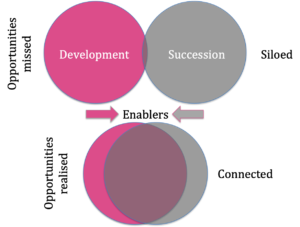26 Jan Development and succession: Two sides of the same coin
Development and succession: Two sides of the same coin is my 101st post on Letting go. Stepping up. Fittingly, it is my first post at the start of the new 2020s decade.
Development and succession: Two sides of the same coin is also special in that it accompanies the unveiling of my new look website.
After seven years, the old site needed to communicate more clearly how I practice as an executive coach, aligning my individual client with their organisation’s strategy, culture, structure and systems – all in the context of the forces at work in the external environment.
Key concept
Individuals are the focus of the development side of the coin. Development enables them to grow in competence, improve their performance and enhance their confidence whether they have been promoted into a new role (transition coaching), need to strengthen their leadership skills (transformation coaching), and/or build their team (supervised coaching).
 Organisations are the focus of the succession side of the coin. The purpose of succession management is to have the right people in the right roles at the right times to drive strategy, nurture culture and align structure and systems.
Organisations are the focus of the succession side of the coin. The purpose of succession management is to have the right people in the right roles at the right times to drive strategy, nurture culture and align structure and systems.
Opportunities are missed in an organisation where the development of individuals is siloed and separated from the management of the talent pipeline to ensure succession.
Sustainable, high-performing organisations tightly connect development and succession. This truism applies in the corporate, government, professional services and family business sectors.
Applying the concept
These are the five enablers that connect development and succession and drive an integrated program up and down and across the organisation:
-
- Assessment of individuals using robust tools that are consistently applied throughout the organisation
- Honest feedback to individuals – based on observed behaviours, fit, performance against agreed KPIs and psychometric inventories – as input to their development plans, against which progress is regularly measured, tracked and reviewed
- Investment in personalised development activities that provide stretching on-the-job experiences, job rotation, education and training, and support from mentors and external executive coaches
- Close involvement of line managers – starting with the CEO – and senior HR leaders in both the development and succession sides of our metaphorical coin
- Transparency about which positions are strategically important and who is in the fast track pipeline.
Key success factors
The three key success factors are [1] development and succession are seen as single strategic system from top management down, [2] the development–succession system is managed as a whole by HR, closely involving line managers and their direct reports, and [3] the system is supported by integrated, organisation-wide processes.
- Developing your Leadership Pipeline by Jay Conger & Robert Fulmer (HBR with tips on transparency)
- Growing Your Company’s Leaders by Robert Fulmer & Jay Conger (a comprehensive ‘how-to’ e-book)


